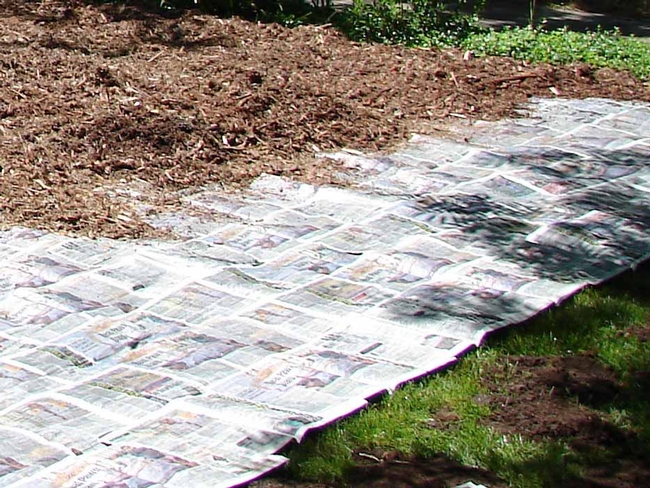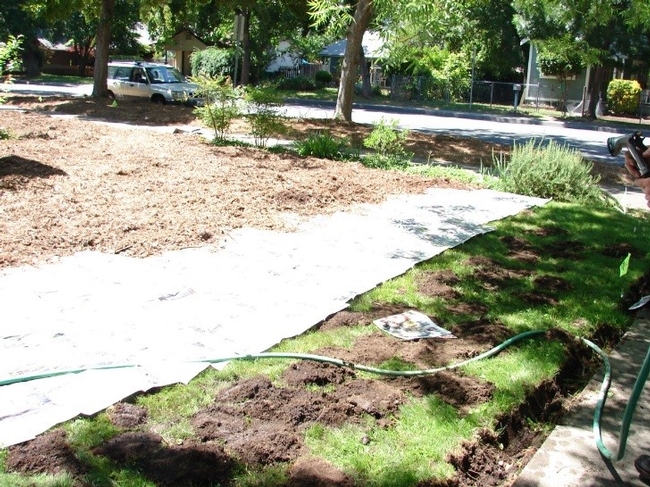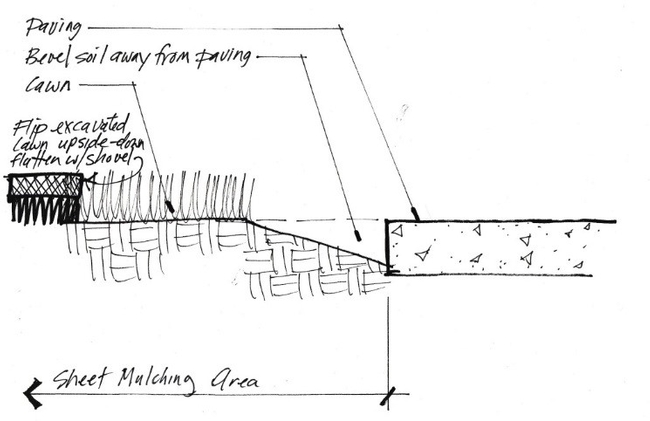By Eve Werner, Butte County Master Gardener, July 3, 2015
California Water Service is currently offering rebates of up to $1000 for lawn removal and replacement with drought-tolerant plants in single-family residences. It's not difficult to realize landscape water savings of over 80% through careful plant selection and site preparation, and accurate application of irrigation according to the plants' actual needs.
If you plan to undertake a lawn replacement, make sure you do it properly; incompletely killed grass can regrow amid new plantings, ruining the appearance of your new landscape and creating a maintenance nightmare. The following three steps will lead to success.
Step One: observe and plan. What existing trees and plants do you want to keep or remove? What are the sun and shade patterns within your yard? What types of grass grow in your lawn? Do you want any additional amenities, such as paving or a shade structure? How will you irrigate your new plants?
Step Two: kill your lawn. Homeowners can use two eco-friendly methods to kill their lawns: Solarizing or Sheet Mulching (also below).
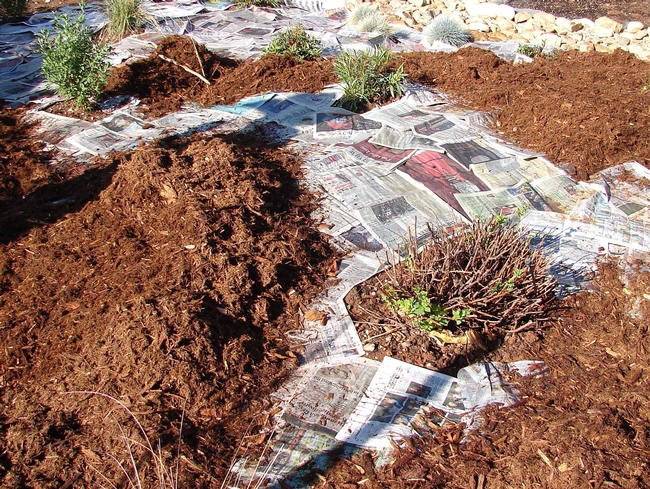
Solarizing uses the sun's radiation to kill lawn grasses as well as many common annual weeds, harmful soil microbes, and seeds down to a depth of 4 to 12 inches in six weeks. Most beneficial microbes survive, including earthworms. Solarizing requires six hours per day of full summer sun and takes 4 to 6 weeks to complete. It works best on fescue, ryegrass, and bluegrass, with partial success on Bermuda grass. Solarizing must be completed before new plants are installed.
Sheet mulching kills weeds by starving them of light. It takes 6 to 10 months and can be started any time of the year as long as at least three months of growing season are included. Sheet mulching works in sun or shade, and is effective on all grasses, including Bermuda grass, and many annual and perennial weeds. It is left in place permanently; over time, the dead lawn, sheeting, and mulch will break down into soil-enriching compost. Sheet mulching should be placed before new plants are installed if being used alone to kill lawn or weeds. It can be placed after plants are installed if solarizing has been completed first. New hardscape and irrigation should be installed before commencing solarizing or sheet mulching.
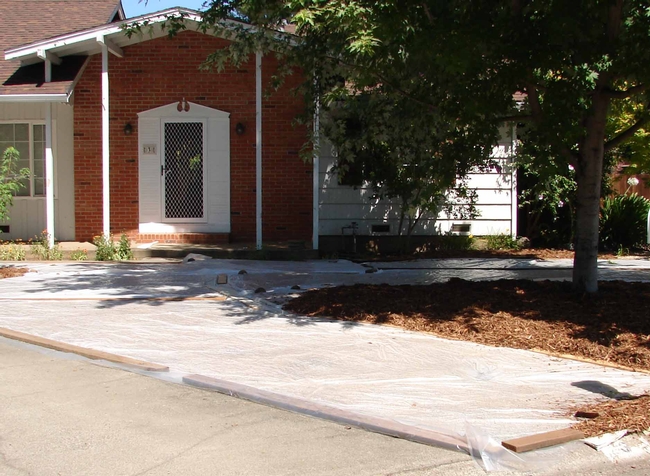
A third option for lawn removal is to dig or scrape out the lawn. Be warned, however, that this method will not kill Bermuda grass and most perennial weeds, which have deep roots that will re-sprout. If you choose to dig out your Bermuda grass lawn, be sure to follow up with sheet mulching to prevent aggressive regrowth of the grass.
Step Three: replant. Whichever method you choose to kill your lawn, time implementation so that you are ready to replant in the fall, winter, or early spring. The cool temperatures and moist soils of our wet season allow drought tolerant plants to develop the healthy roots they need to thrive with little water during the heat of summer. Taking time to thoroughly kill the grass and waiting until the climate conditions are suitable for new plants will ensure the long-term success of a lawn replacement project.
For additional information about the CalWater turf replacement rebate, visit their website at www.calwater.com.
Photo credits: Eve Werner
Sheet Mulching, By Eve Werner, Butte County Master Gardener
Sheet mulching, also known as sheet composting, kills weeds by starving them of light. Dead plant material will break down into compost to enrich the soil. New weeds are reduced because it is difficult for them to anchor their roots in deep mulch. The sheeting and the mulch will break down over time, forming compost. Sheet mulching should be placed before new plants are installed if being used to kill lawn or weeds. It can be placed after plants are installed if other weed removal techniques such as solarizing have been completed first.
Materials:
- Newspaper or plain cardboard. Don't use glossy colored pages as they may contain metal pigments.
- Water from a hose with a spray attachment.
- Compost or worm castings in a 1-2” layer. Quantity calculation for mulch is: (Area in square feet) x .08 to .15 ÷ 27 = cubic yards of compost required. Note, if you are replanting with native CA plants, you can omit this step.
- Wood chip mulch in a 4”-6” layer. ‘Walk-on' bark, has longish strips of wood and barks that knit together to help it stay in place. Shredded wood/barkmayalsobeavailablethrougharborists for much less cost; verify with the supplier that it is disease free.
- Quantity calculation for mulch is: (Area in square feet x .33 to .5) ÷ 27 = cubic yards of mulch required.
Process
- Scalp your lawn or weedy area with mower set at lowest setting. Remove grass/weed clippings.
- Water the soil thoroughly. To prevent runoff, you may have to apply water for a short period, wait for it to soak in, and then repeat as needed.
- To reduce spillage of mulch onto adjacent paving, dig a shallow beveled trench along any edges that are bordered by paving. See drawing, below.
- Spread 1-2” depth of compost or worm castings over entire area.
- On a windless day, place newspaper (about 5-8 sheets thickness) or cardboard over grass to be killed, overlapping like shingles. Make sure there or no gaps or holes. Lightly sprinkle newspaper with water as you go to prevent it from blowing away. Once wet, the paper will easily tear; be careful when walking on it. If it tears, place additional newspaper over the hole.
- If you are laying the sheeting around existing plants, keep the paper a foot from the plant stem, further for plants that spread by underground stems.
- As you are laying the paper, place wood mulch over the top of the paper to a 4”-6” depth. Place the mulch as you lay the paper so you don't have to walk on/tear the wet paper. If you are placing the mulch when the plants are already in the ground, keep the mulch a foot from the plant stem.
- Sheet mulching requires 6-10 months to kill a lawn. It can be left in place permanently.
- To plant with sheet mulching in place, push back the mulch and cut away paper sheeting in a circle wide enough to dig your hole. Dig the planting hole 2x the width and 1x the depth of the plant root ball. Loosen coiled roots and place the plant in the soil so that the top of the root ball is slightly above the adjacent soil. Back fill with soil from hole, forming a slight rim at the edge of the planting hole. Replace mulch, keeping it 8” from the plant stems.
Sheet Mulching in Progress
Beveled trench along the sidewalk, newspaper layered 5-8 sheets thick, and an initial layer of wood chip mulch.
Beveled Trench Diagram
